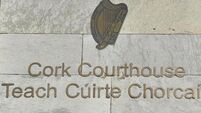A journey to bring Ulysses to the masses
On January 1 next the European copyright on James Joyce’s published works expires. The expiration brings down the curtain on one of the most jealously guarded literary estates of the last century. On the evening of January 1, a Cork artist is bringing to the stage a much acclaimed interpretation of the Dubliner’s most renowned work, Ulysses, which is based around a day in the capital city. The journey from Joyce’s imagination at the beginning of the last century, to an adaptation of Ulysses in the early decades of the 21st century is a story in itself.
Fortunes have been made from Joyce’s work, particularly Ulysses, the sprawling novel that revolves around a day in the life of Leopold Bloom. Like many before him, Joyce’s genius only rippled out to a wider audience after his death. He spent most of his life in penury, suffering for his art, and, according to some accounts, making others suffer plenty too.
He left Dublin soon after completing his studies in UCD. First stop was Paris, a hive of literary and artistic figures in the 1920s. Among the more serious drinkers with whom Joyce fraternised was a young Ernest Hemingway.
Joyce’s ill health and that of his daughter Lucia eventually prompted a permanent move to Zurich, where Lucia was treated for schizophrenia, and Joyce for his failing eye sight. Through his contacts he managed to have Lucia treated by the renowned psychoanalyst Carl Jung, who came to the conclusion that the disease of the mind affected father as well as daughter.
He died in Zurich in 1941, an exile, an artist who felt he had long been misunderstood, a writer with nary a bean in his pocket.
While he couldn’t live in Dublin, he never left the city in his imagination. All his great works, including the tome of short stories, Dubliners, were rooted in his native city.
Joyce is now associated throughout the world with the capital city, but less attention is given to his strong connections with Cork. The association has been explored by, among others, Professor Colbert Kearney of UCC and by theatre director Michael Finn, who reimagined a portrait of the artist as a teenager revisiting Cork with his father to sell off family property.
Joyce’s family were businesspeople of long standing in the city. Even after migrating north, his father John was long reputed to be something of a bore in the manner in which he never stopped talking about the city by the Lee, and how his family had been such important pillars in the everyday life of Corkonians.
In fact, his family going back two generations had been stone masons who got into property development (Et tu, Mr Joyce?), and eventually owned a salt and lime business based in White Street in the city. The business was vital in the late 19th century for providing material for butter making in Cork.
Roll things on to the latter decades of the twentieth century, and another son of Cork’s business classes joined the legions of Irishmen and Irishwomen who took to the skies in the recession of the 1980s.
After completing his studies in UCC, Pat Fitzgerald struck out for New York. His family own Fitzgerald’s Electric on the Grand Parade, where his brother Paul continues to man the tiller. After a time working the bars of the Upper East Side, Pat Fitz found what he was looking for and drifted into the precarious world of acting.
He made his debut in the Irish Reparatory Theatre’s first production and went on to accumulate a whole range of roles in theatre, film and television stateside, picking up various awards along the way.
Like many others, he saw a shimmer ripple across the green, green grass of home when the Celtic Imposter began to roar at the turn of the century. He returned, locating himself in Dublin and attempted to carve out a niche. He was in the wrong business. If he had been a developer like Joyce’s forebears, things could have come together, but like many artists before him, he found that Ireland was a cold house for those whose main focus wasn’t turning a buck.
Once back in New York, he began to examine the possibility of adapting the work of his fellow exile and literary hero. For a number of years he experimented with a play under the title ‘Bloom’s Day’, but eventually — anything to do with Ulysses has to have an ‘eventually’ — he changed direction and started working with a fellow actor Cara Seymour. Soon after Terry Kinny, co-founder of the Steppenwolf Theatre in Chicago, and most recently seen as an actor in The Mentalist, came aboard as consultant director.
The new adaptation was given the title Gibraltar and first performed in New York in October 2010. Both audiences and the critics loved it. The theatre review Backstage summed it up thus: “A simple, heartrending story that resonates with the profound mysteries of love and desire, regret and affirmation, it’s also extremely bawdy.”
Taking the production back to the city from which its subject sprung was another matter. In Europe, the copyright on work published in the lifetime of an author persists for seventy calendar years after the author’s death. That tenure expires on New Year’s Day.
Fitzgerald booked his production in the New Theatre in Temple Bar. He has not received any funding so far for his production. In a tradition that resonates down through the years, Fitzgerald was to find that for some artists, the breath of their imagination is beyond the ken of officialdom.
Instead, Pat Fitz turned to a form of sponsorship for which the likes of Joyce would have killed. The global internet funding platform IndieGoGo.com provides for members of the public to contribute to the production of all manner of creative works. No contribution is too small.
The dollar signs have begun clicking up for Gibraltar, but it’s still a long way to go to the sum which will ensure that the creator will not have to suffer serious debt for his art.
Ulysses can be tough going. I’ve had a few runs at it myself, but on each occasion I hit the wall early on. Fitzgerald’s interpretation is now an opportunity to bring this great work to the masses.
Currently, in our winter of discontent, there is much talk about the value of culture to the country. The tradition of artists, and writers in particular, is held up as both an example of what we can be, and a resource to be exploited.
Then along comes somebody who has thrown himself into the work of one of our greatest writers, and has hewn from it an interpretation that is both accessible, and, according to the critics, uplifting. The response from official Ireland is as it has always been for such individuals. In this instance, official Ireland has, to paraphrase Yeats, disgraced itself once again.















